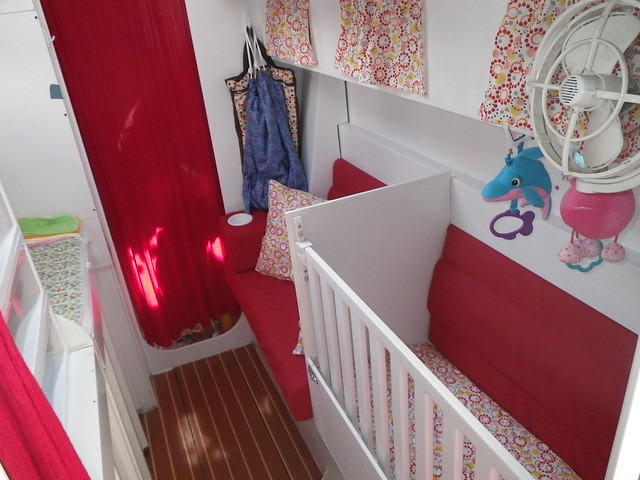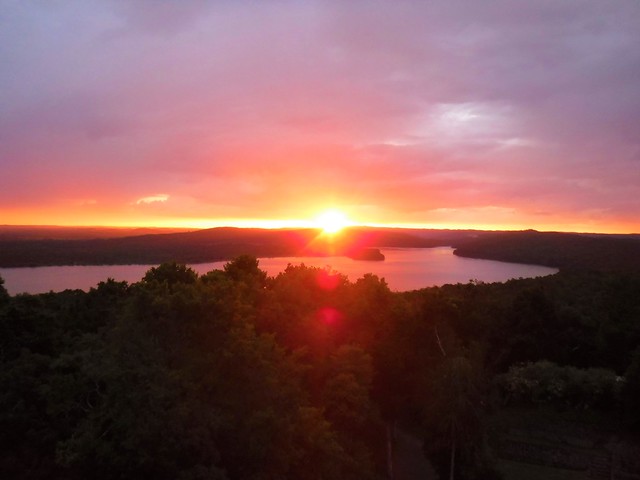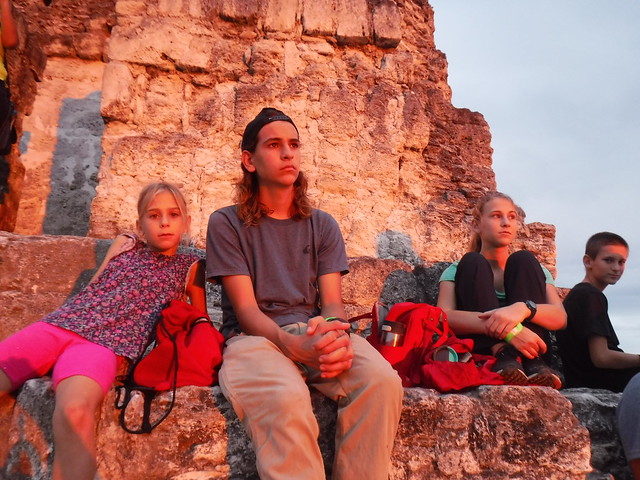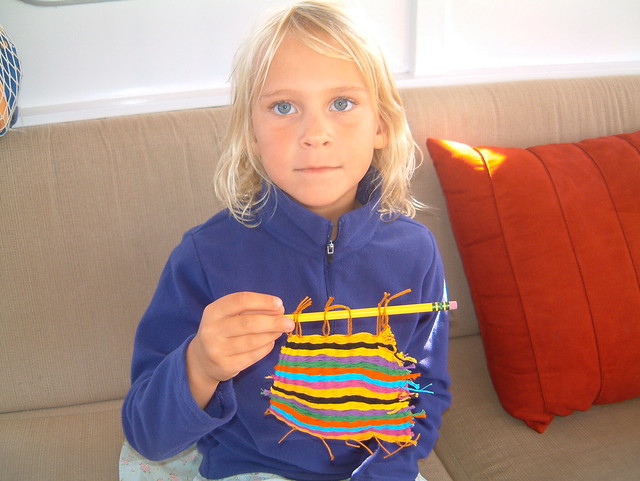I know I have touched on this subject briefly before in previous posts. I have talked about grinding grain and making bread, taking the dinghy to get groceries, and storing freeze-dried food for long trips. This time I’d like to focus on what it’s like to shop at island “grocery stores,” some of which more closely resemble a closet than a market, to find food for growing children who eat like a pack of half-starved wild dogs. I’ll also cover the fun of learning to “eat like the locals,” and the joys of stumbling upon a beautiful, clean, well-provisioned store where you least expect it. If you’re on your way down-island, here’s what you might expect to find.
First, I want to mention that when we started out, we had a six-year-old, a five-year-old, a four-year-old and a nursing toddler. If I made a lasagna, for example, it would provide us with two dinners, or a dinner and two lunches. If I provisioned for a long trip, I could go two weeks to one month before I needed a grocery store for fresh food. In a pinch, eating only dried and canned food, we could have gone six months. We now have two teen-aged boys, 15 and 14, a 12-year-old daughter who is taller than I am, a 10-year-old boy who engages in competitive eating with his brothers, and a five-year-old who can’t afford to be picky. If I make a lasagna now, it’s gone before you can say “Mangiamo!” –-scarfed down with two loaves of garlic bread and two heads of broccoli. Leftovers are a thing of the past. We still store freeze-dried food, grains, and some canned goods, but what used to be a six-months’ supply now lasts three months. Meat is no longer something we have for the main course, but an ingredient in a one-pot meal. Provisioning has taken on a whole new look, requiring two carts at the big stores, a taxi ride, a 13-foot RIB dinghy to cart it all home, and, sometimes, two trips per week.
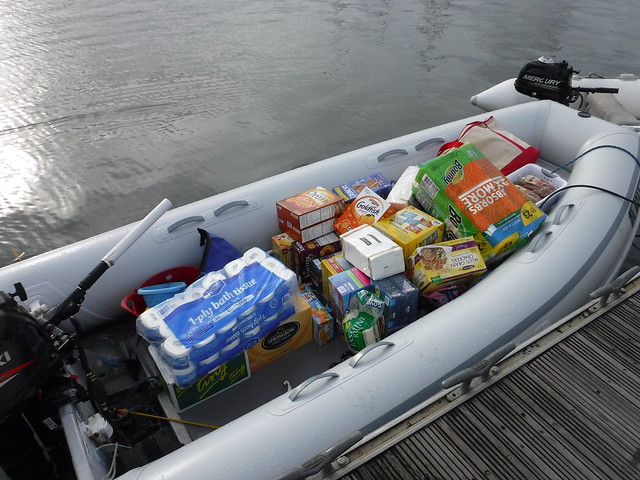
Second, a quick note on the Bahamas. Before I leave the U.S., I fill the freezer with meat, and order freeze-dried produce, much of which gets used on this leg of the trip. Nearly everything in the Bahamas must come in by boat. With the exception of Eleuthera/Spanish Wells, where you can find locally-grown mangoes, carrots and cabbage, most of the stores are expensive and stock only packaged foods, mystery meat, and anemic-looking produce from Canada. One thing I will say about the Bahamians: they are good bakers! Do not miss the coconut bread or johnny cakes (journey bread). Good cheese and butter from Ireland or New Zealand can often be found as well, but you’ll have to pay attention to when the mail-boat comes in, or there will be no eggs, milk, or produce to be found. For more information about freeze-dried food, see my previous post Don’t Just Survive—THRIVE.
After spending a month in the Bahamas last March, we skipped the Turks and Caicos and the Dominican Republic, opting for a long ocean passage to Puerto Rico instead, so by the time we arrived in the Caribbean, we had eaten all the snack-y things, the freezer was empty, all the fresh food was gone, and we had eaten into our freeze-dried supplies. But we knew Puerto Rico has a COSTCO, so we weren’t concerned about the loss of provisions we had bought for the Caribbean “trip.” So, we stocked up again, using a rental car and multiple trips to buy familiar items and things we like to have in bulk (like toilet paper!). Which brings me to a principle by which I always abide: if you find something you like in an island store, stock up—it may be a long time before you see it again! It may be expensive, or you may convince yourself that you don’t really need that much maple syrup, for example, but I guarantee that at some point, you will regret not having purchased more of your favorite items.
Finally, here is a shop-by-shop review of the island stores we have visited on our way down the Eastern Caribbean, and a few as we’ve headed west. Included in the list are a few of our favorite local dishes. I’ve labeled the islands with dollar-signs to indicate, roughly, whether the shopping was more or less expensive than I’m used to. ($=less expensive than Florida prices, $$=equivalent to Florida prices, and $$$=more expensive than Florida prices.) As always, I thank my friend Kimberly on s/v Ally Cat for her notes that helped me find some of these places on our way down.
Bahamas ($$$): Stock up for further travels in Georgetown, Exuma at the Save-Rite and Exuma Markets. Go on the afternoon of mail-boat day, or the morning after, to give the store some time to put out the new stock. We do not love conch, but if you do, try the conch salad or cracked conch in restaurants. Besides fresh-caught seafood and coconut bread, the food in the Bahamas is nothing to write home about.
Puerto Rico ($$): With a COSTCO and well-stocked grocery stores, provisioning is not a problem in Puerto Rico. We were at a marina and had a rental car, which made everything easier. As a former Spanish colony, you will still find things like imported chorizo, Manchego cheese, and Rioja wines from Spain, as well as local produce, coffee, and rums (try the Bacardi 8 or the Don Q Anejo).
Tortola, BVI ($$$): In Road Harbor, you’ll find the RiteWay, a huge, well-stocked store not far from the Moorings/Sunsail charter boat docks, and a smaller one less than a block from TMM Yacht Charters/Doyle Sail Loft. I didn’t see another store like this until Antigua. The BVIs are full of tourists, so finding what you like isn’t a problem. Getting off the beaten path is a little more challenging. If you look for it in a restaurant where locals eat, you might be able to try Goatwater Soup—it sounds disgusting, but is actually quite delicious. Buy some Pusser’s rum while in the BVI’s and learn how to make a Painkiller. The name says it all.
Anguilla ($$)—From Sandy Ground, rent a car or take a taxi to the Best Buy (West), a nice, large store with a deli counter. Look for Ting soda, made from Caribbean grapefruit. It can be found on some islands, but not on others. It became a passage favorite among our crew. If you skip Anguilla, St. Martin/Sint Maarten has everything one could possibly want at reasonable prices. Many people stop there in order to re-provision.
Nevis ($$)—We didn’t have much use for bustling St. Kitts, so we headed to much-quieter Nevis. One can walk to the small Super Food or take a taxi to the larger Horsford’s Valu-Mart IGA. One thing I notice about all island grocery stores is that they smell like salted, smoked fish. I was given a recipe for a breakfast hash that includes said smoked fish. It has to be soaked, drained, and twice-cooked to make it edible. I could never bring myself to buy it.
Antigua ($$$)—In Jolly Harbor, the Epicurean store is an easy walk from the dinghy dock at the marina, and was well-stocked with things I hadn’t seen in a long time, like my favorite kosher teriyaki sauce, Soy Vey! If you are in Antigua at the right time (June/July), there will be a profusion of mangoes of all kinds, very inexpensive at roadside stands. A small-but-sweet local pineapple can be found there as well, called a black pineapple.
Dominica ($)—If you’re anchored in Porstmouth, you will be visited by boat boys selling local produce. Try some new things; Dominica grows the most amazing fruits and vegetables. Something called an “apricot” (a.k.a. zabrico, or mammee apple) grows in abundance there and is delicious. Also look for sugar apples, passion fruit, papaya, soursop, and canips (a.k.a. chin-ups or skin-ups). I’m sure there are big stores in Roseau, but we did most of our shopping at small, local markets in Portsmouth, where the selection of produce, eggs, bread, and fish was excellent. I had my first traditional “cocoa tea” in Dominica, a drink made from raw chocolate (with the cocoa butter intact) and brown sugar. Not to be missed.
Martinique ($)—I stopped at nearly every boulangerie I passed, enjoying the first real French bread and pastries I’ve had since Paris. The “8-á-Huit” chain (I shopped at one in St. Pierre and in St. Anne) is good, and posts hours, as you would expect, from 8 a.m. to 8 p.m. There’s an upstairs, too—don’t miss it! The Leader-Price in Fort-de-France was an easy walk from the dinghy dock at the park, and had an excellent selection of VERY inexpensive French wine. (Oh, why did I not buy more?!) I have been told that there are excellent stores with dinghy docks in Le Marin. Stopping at a crêperie was a special treat in Martinique.
St. Lucia ($$)—Rodney Bay had a surprising number of supermarkets owned by Massey. By dinghy, you can walk a few blocks to the Massey Super J from the small dock near the tapas place. If I couldn’t find what I needed at the Super J, then the Massey Gourmet across the street would have it. A taxi ride away from the IGY Rodney Bay Marina, there’s a Mega J (like a Sam’s or COSTCO). Jay’s favorite sipping rum comes from St. Lucia, Admiral Rodney.
Bequia (Grenadines) ($$)—Port Elizabeth has lots of little shops and restaurants. I bought staples at Knight’s Trading, and excellent fresh produce from stalls/wagons on the street. Bread fruit is everywhere in the islands, but you may not know what to do with it. You can buy it fire-roasted or fresh, and find it fried in restaurants, where it looks and tastes similar to French fries.
Union (Grenadines) ($$)—The town of Clifton is small, but has a few stores, including a bakery. The produce is local and found at roadside stands. I first bought Christophene (a.k.a. chayote) here—an excellent alternative to broccoli or cauliflower, peeled, chopped, and sautéed with green onions and garlic.
Grenada ($$)—Head to the Spiceland Mall IGA (by bus) or Food Land near Port Louis (by dinghy). Also near Port Louis, there is an excellent bakery, the Merry Baker, and a restaurant, Patrick’s Local, which serves small plates for sharing (tapas style) of a dozen or so local dishes. It’s a fixed menu, but you must make a reservation so they know how much to prepare. This is an excellent introduction to island specialties, like stewed pumpkin, crayfish soup, and green banana salad. While in Grenada, don’t miss “Oildown,” a stew made with chicken, vegetables, coconut milk, “provision” (Irish potatoes, plantains, cassava, breadfruit, etc.), and very firm dumplings. And don’t forget to stock up on spices while on the Spice Island! Note that their “bay leaves” are not the flavor of bay laurel, but more like cloves (very nice in rice).
Bonaire ($$)—Heading west to the ABCs, you will find special items that come on ships straight from Europe (like Dutch Gouda and Danish butter). While arid Bonaire grows little but cactus (from which they make a spirit), they import an impressive selection of produce. You can walk to the Chinese grocery in town, or, if you’re on a mooring ball, the marina offers a free shuttle to the Van den Tweel. I walked into this lovely, clean, well-stocked store and literally wept tears of joy. It was the nicest grocery store I had been in since I-can’t-remember-when. For breakfast, I recommend pannenkoeken (thin pancakes) with eggs and gouda. We went straight to Colombia from Bonaire, but I’ve heard Curaçao and Aruba have good provisioning, as well.
Santa Marta, Colombia ($)—Two blocks from the IGY marina, there is a lovely grocery store, Carulla, with a super-friendly staff and an excellent selection of South American produce (try mangosteen or uchuvas for snacking, or lula for juicing). For a big provisioning trip, take an inexpensive taxi ride to the Jumbo (like a Super Target). If you’re looking for Colombian coffee, I can recommend the whole-bean, dark roast “Sierra Nevada” from Juan Valdez coffee shop. It used to be hard to find export-quality coffee inside Colombia, but Juan Valdez makes it possible. Other things to try in Colombia, arepas con ceviche de camarrones (thick tortillas with shrimp ceviche), or patacones con suero costeño (fried smashed green plantains with sour cream). Arepas can also be bought at the store and are good for breakfast with ham and eggs.
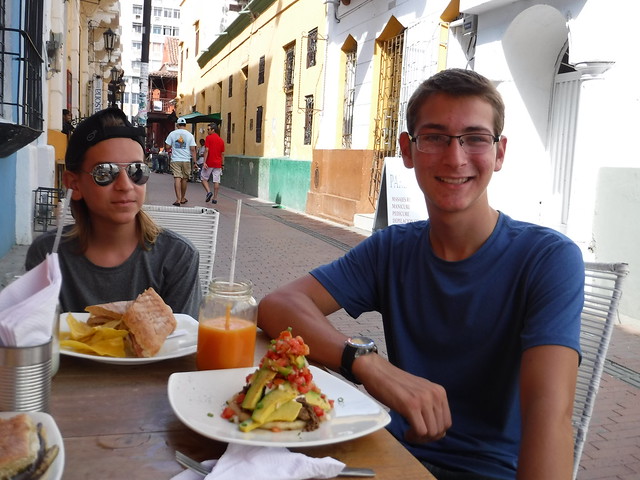
Bocas del Toro, Panama ($)—Provisioning here proves a bit of a challenge, as there aren’t many places to dock a dinghy. We are staying at the Red Frog Marina on Isla Bastimento, and they have a small market at the marina and a free water shuttle to Bocas Town four times each week. Water taxis, if you don’t want to use the free shuttle, cost $7-10/pp each way. There are plenty of stores and excellent fresh produce, including locally-grown bananas and pineapples. Pick-up truck taxis in town cost $0.65/pp and you flag one down and load your groceries in the back to head to the waterfront. Walking distance from the water taxi dock, you can find produce, Christina Supermarket, Isla Colon Market, and The Super Gourmet, the last of which has items you might not find elsewhere (for a price!). A little farther away, the Panaderia Alemana has very good bread. A dairy truck arrives on Tuesdays, and you can buy fresh milk (not UHT!) right out of the truck. A note on meat: the chicken and eggs are excellent and easy to find, but the beef is pretty tough, so I buy ground hamburger, primero with less fat, and secundo with more fat. Chorizo is easy to find, and the smoked pork chops, chuletas, are a Panamanian specialty and delicious. Shopping is said to be great in David, a bus-ride away, or can be done remotely with the help of Toby and Lola.
I’m still draggin’ my wagon all over the place to shop for food, and will continue to do so in the rest of Central America. After we complete our Caribbean circuit, I’ll write a second installment to let you know what else I find!


